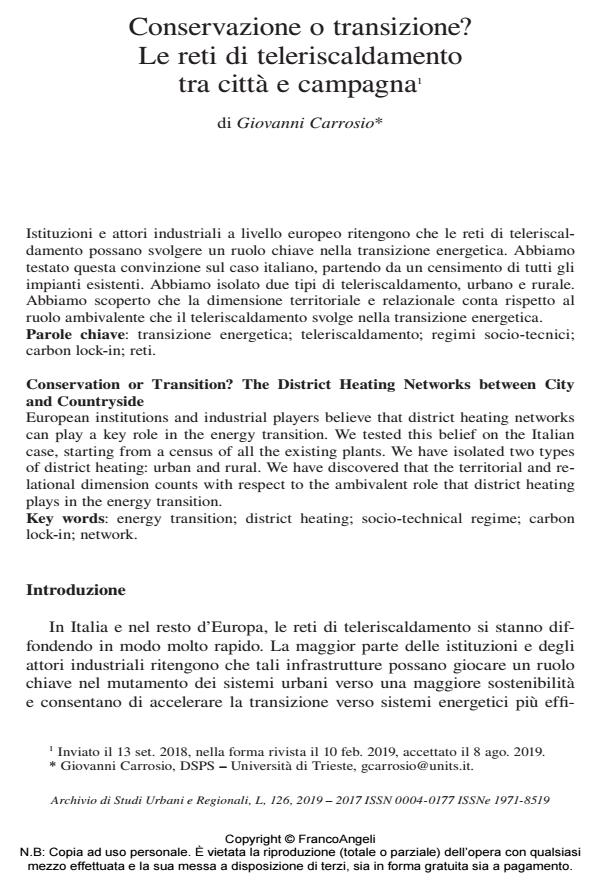Conservazione o transizione? Le reti di teleriscaldamento tra città e campagna
Titolo Rivista ARCHIVIO DI STUDI URBANI E REGIONALI
Autori/Curatori Giovanni Carrosio
Anno di pubblicazione 2019 Fascicolo 2019/126 Lingua Italiano
Numero pagine 21 P. 32-52 Dimensione file 375 KB
DOI 10.3280/ASUR2019-126003
Il DOI è il codice a barre della proprietà intellettuale: per saperne di più
clicca qui
Qui sotto puoi vedere in anteprima la prima pagina di questo articolo.
Se questo articolo ti interessa, lo puoi acquistare (e scaricare in formato pdf) seguendo le facili indicazioni per acquistare il download credit. Acquista Download Credits per scaricare questo Articolo in formato PDF

FrancoAngeli è membro della Publishers International Linking Association, Inc (PILA)associazione indipendente e non profit per facilitare (attraverso i servizi tecnologici implementati da CrossRef.org) l’accesso degli studiosi ai contenuti digitali nelle pubblicazioni professionali e scientifiche
Istituzioni e attori industriali a livello europeo ritengono che le reti di teleriscaldamento possano svolgere un ruolo chiave nella transizione energetica. Abbiamo testato questa convinzione sul caso italiano, partendo da un censimento di tutti gli impianti esistenti. Abbiamo isolato due tipi di teleriscaldamento, urbano e rurale. Abbiamo scoperto che la dimensione territoriale e relazionale conta rispetto al ruolo ambivalente che il teleriscaldamento svolge nella transizione energetica.;
Keywords:Transizione energetica; teleriscaldamento; regimi socio-tecnici; carbon lock-in; reti.
- ARIU (2017). Il riscaldamento urbano. Annuario 2017. Milano: Editrice Alkes.
- Arthur W.B. (1989). Competing technologies, increasing returns and lock-in by historical events. Economic Journal, 99: 116-131.
- Beck U. (2016), Disuguaglianza senza confini. Roma-Bari: Laterza.
- Carrosio G. (2010). Biomasse: Dobbiaco e Campo Ligure. In: Osti G., a cura di, La co-fornitura di energia in Italia. Casi di studio e indicazioni di policy. Trieste: EUT.
- Carrosio G. (2015). Politiche e campi organizzativi della riqualificazione energetica degli edifici. Sociologia Urbana e Rurale, 106: 21-44. DOI: 10.3280/SUR2015-10600
- Chiesi A.M. (2019). L’analisi dei reticoli. Milano: FrancoAngeli.
- Upham P. and Jones C. (2012). Don’t lock me in: Public opinion on the prospective use of waste process heat for district heating. Applied Energy, 89(1): 21-29. --
- Unruh G.C. (2000). Understanding carbon lock-in. Energy Policy, 28(12): 817-830. DOI: 10.1016/S0301-4215(00)00070-
- Valente T.W. (2005). Network models and methods for studying the diffusion of innovations. In: Carrington P., Scott J. and Wasserman S., Models and Methods in Social Network Analysis. Cambridge: University Press. DOI: 10.1017/CBO9780511811395.00
- Smith A., Stirling A. and Berkhout F. (2005). The governance of sustainable socio-technical transitions. Research Policy, 34: 1491-1510.
- Späth P. and Rohracher H., (2015). Conflicting strategies towards sustainable heating at an urban junction of heat infrastructure and building standards. Energy Policy, 78: 273-280.
- Pestoff V. and Brandsen T., (2006). Co-production. The Third Sector and the Delivery of Public Services. NY: Routledge. DOI: 10.1080/1471903060102287
- Osti G. (2008). Relazioni fra consumatori e produttori nel campo delle fonti energetiche rinnovabili. Sociologia urbana e rurale, 85: 41-56. Osti G. (2015), Energia e urbanizzazione: un gioco nuovo e incerto. Sociologia Urbana e Rurale, 106: 7-20. DOI: 10.3280/SUR2015-10600
- Meadowcroft J. (2011). Engaging with the politics of sustainability transitions. Environmental Innovation and Societal Transitions, 1(1): 70-75.
- Magnani N. (2018). Transizione energetica e società. Milano: FrancoAngeli.
- Lund H. (2005). Large-scale integration of wind power into different energy systems. Energy, 30(13): 2402-2412.
- Longo F. (2005). Governance dei network di pubblico interesse. Logiche e strumenti operativi aziendali. Milano: Egea.
- Liebowitz S. and Margolis S.E. (1995). Path dependence, lock-in and history. Journal of Law, Economics and Organization, 11(1): 205-226.
- Lake L., Rezaie B. and Beyerlein S. (2017). Review of district heating and cooling systems for a sustainable future. Renewable and Sustainable Energy Reviews, 67: 417-425.
- Leurent M., Da Costa P., Rämä M., Persson U., Jasserand F. (2018). Cost-benefit analysis of district heating systems using heat from nuclear plants in seven European countries. Energy, 149: 454-472.
- Islas J. (1997). Getting round the lock-in in electricity generating systems: the example of the gas turbine. Research Policy, 26: 49-66. DOI: 10.1016/S0048-7333(96)00912-
- Hughes T.P. (1983). Networks of Power: Electrification in Western Society, 1880 e 1930. Baltimore: Johns Hopkins University Press.
- Geels F.W. and Schot J. (2007). Typology of socio-technical transition pathways. Research Policy, 36: 399-417.
- Geels F.W. (2014) Regime resistance against low-carbon transitions: introducing politics and power into the multi-level perspective. Theory Culture & Society, 31(5): 21-40. DOI: 10.1177/026327641453162
- Geels F.W. (2002). Technological transitions as evolutionary reconfiguration processes: a multi-level perspective and a case-study. Research Policy, 31: 1257-1274. DOI: 10.1016/S0048-7333(02)00062-
- Fritsch M. and Kauffeld-Monz M. (2010). The impact of network structure on knowledge transfer: an application of social network analysis in the context of regional innovation networks. The Annals of Regional Science, 44: 21-38.
- Dzebo A. and Nykvist B. (2017) A new regime and then what? Cracks and tensions in the socio-technical regime of the Swedish heat energy system. Energy Research & Social Science, 29: 113-122.
- Connolly D., Lund H., Mathiesen B.W., Werner B., Möller B., Persson U., Boermans T., Trier D., Østergaard P.A. and Nielsen S. (2014). Heat Roadmap Europe: Combining district heating with heat savings to decarbonise the EU energy system. Energy Policy, 65: 475-489.
- Cowan R. (1990). Nuclear power reactors: a study in technological lock-in. The Journal of Economic History, 50(3): 541-567. DOI: 10.1017/S002205070003715
- Coenen L., Benneworth P.S. and Truffer B. (2012). Toward a spatial perspective on sustainability transitions. Research policy, 41(6): 968-979.
Giovanni Carrosio, Conservazione o transizione? Le reti di teleriscaldamento tra città e campagna in "ARCHIVIO DI STUDI URBANI E REGIONALI" 126/2019, pp 32-52, DOI: 10.3280/ASUR2019-126003